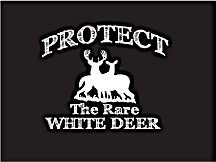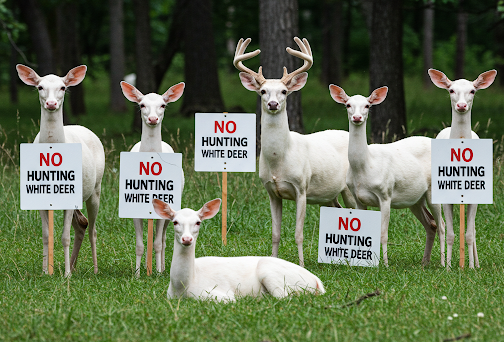
Wisconsin’s White Deer Back in the Crosshairs
April 2, 2025

A group of participants at a recent Wisconsin White Deer Convention (WWDC)
pose for a photo after delegates voted unanimously to oppose any proposal to
hunt white deer in Wisconsin. (AI Image by Protect the White Deer)
Destruction of a precious natural resource?
A foot in the door for hunting white deer statewide?
Bad publicity for hunters?
These are the things that could happen if citizen participants in Wisconsin’s 2025 Spring Hearing approve a proposal to “legalize the harvest of white deer” in Wood, Marathon, Portage, Winnebago, and Jefferson counties.
The Spring Hearing is conducted by the Wisconsin Conservation Congress (WCC), a unique Wisconsin organization that was started by Aldo Leopold in 1934 as a way to involve citizens in conservation issues and policies.
Participants in the hearing can fill out a questionnaire on mostly hunting, trapping, and fishing issues. The results are nonbinding, but can be used by the DNR to make policy decisions. There are also guidelines for citizens to enter their own questions for future hearings.
The 2025 questionnaire can be viewed now, but voting is only open April 14 at county locations or online from April 14-16. The proposal to allow hunting white deer is broken down into five questions (69-73)–one for each of the five counties under consideration.
This is the fourth time in the last twelve years that a proposal to hunt white deer has been placed on the ballot. Previous years were 2014, 2015, and 2021 (See “Groundhog Day at the WCC”). None of the proposals passed.
In 2017 and 2019, WCC chair at the time Larry Bonde also made a direct request to the DNR Board to allow hunting white deer. The board was not interested. One member said, “This needs to be left alone and they need to stay protected.” Another said, “I live in Marathon County and I’ve never seen one.”
Larry Bonde is currently on the WCC’s CDAC Advisory Council. White deer hunting advocate Rob Bohmann is chair of the WCC’s Deer and Elk Advisory Committee and is also a delegate on the WCC’s District Leadership Council, which entered this year’s white deer proposal. The same people continue to push the hunting issue.
The paragraph preceding this year’s white deer question argues that white deer populations in the particular counties listed are increasing—to the point where hunters are missing “harvest opportunities.” The proposal also claims “several landowners and municipalities are experiencing damage” as a result of the growing numbers.
A few comments and corrections are in order…
Populations–
First off, a group of white deer in your back field does not constitute an overpopulation, and frequently seeing the same white deer on your drive home from work does not mean they are common.
If there are so many white deer in the counties where hunting is being proposed, where are the numbers? The DNR admits that no formal counts have ever been done.
The DNR did do an informal survey of white deer in 2020 using social media and the department’s large mammal observation form. Only 30 white deer were reported in Wood County (out of an estimated 30,000 total deer). Thirteen white deer were reported in Marathon, 13 in Winnebago, 3 in Portage and only 2 in Jefferson. Fifty-one out of 72 counties in the survey did not report any white deer at all.
A 2019 survey compiled from Snapshot Wisconsin, a program that uses trail cam photos to provide the DNR with wildlife information, recorded only 3-5 white deer each in Wood and Marathon counties. Neither of these surveys were in any way comprehensive, but they do give a relative picture of numbers and locations of white deer in the state.
Scarcity–
Even if there were a “large” number of white deer in one area, it does not take into account the greater rarity of white deer. What is striking about studying white deer and their populations is how truly rare they are–even in states like Wisconsin where they are protected.
If white deer are already very rare, what will happen to them if they are hunted?
A landowner near Wausau or Wisconsin Rapids might want the right to shoot a white deer on his own property, but if hunting is legalized, how many hunters will be coming in from other parts of Wisconsin, or even Minneapolis and Chicago, looking for a trophy?
It brings to mind early accounts (before surveys and game regulations) of farmers who saw a handful of passenger pigeons in a tree, grabbed a gun, and unknowingly killed the last members of an entire species. White deer are not a species, but the results could be the same.
An unpredictable future–
Some further caution for eager hunters: Even if you are seeing a fair number of white deer now, that may not be the case in the future. Populations are not always stable.
The Leland area of Sauk County at one time had an estimated 30 white deer, but numbers of both white and brown deer have decreased significantly. CWD (Chronic Wasting Disease) and EHD (Epizootic Hemorrhagic Disease) have taken a toll.
In the case of the white deer, several of the older does that reliably produced white fawns for years are now gone. Coyotes have also become a plague on newborn fawns (both brown and white).
Do not take your white deer for granted!
The trophy mentality–
Some hunters want the opportunity to shoot a white deer, but many hunters just enjoy watching white deer and want them protected.
A 2014 WCC Spring Hearing proposal to “Legalize the harvest of white and albino deer statewide” was voted down 3939 to 1915 by largely hunter participants. So what is really behind the drive to legalize hunting?
Is the “need” to hunt white deer coming from a sense of “missed opportunity” and to prevent potential “damage,” as hunting proponents argue? Or is it from a desire to shoot a rare and beautiful animal and hang it on the living room wall–aka, to bag a trophy?
Bad publicity–
A point that is often overlooked in the white deer issue is how it reflects on hunters. When a hunter shoots a popular neighborhood deer, even legally, it does not go over well with the public.
Such kills in Leland, Missouri, and Michigan created both national news and a national outcry. There is obviously an ethical question here, but there is also an image one.
Trophy hunters demand their right to shoot a white deer–no matter how much a community loves it, how many people take photos, or how many enjoy seeing it. In the end, it makes every hunter look bad.
Deer damage–
“Several landowners” are supposedly “experiencing damage” from white deer in the counties mentioned in the WCC hunting proposal.
White deer are still a tiny percentage of the overall deer herd, so removing brown deer in a damage situation is a much better solution than shooting the white ones (and the brown deer are already legal game).
Regarding the complaint about white deer causing damage in municipalities, this is a first. A more typical reaction if a white deer wanders into a town or city is amazement. The response isn’t to chase it away, it’s to grab a cell phone and take a picture. The whole event then becomes the featured story on the evening news.
If a homeowner feels they need to protect their shrubs, there are various “deer-be-gone” concoctions at the local garden center or hardware store that work great to fend off browsers. The DNR also has a program to provide compensation to farmers for crop damage caused by wildlife.
A public resource–
A bigger question in this whole issue is, who actually “owns” the white deer, or any deer for that matter?
Wildlife in Wisconsin is considered the public property of all citizens and is managed (theoretically) for the benefit of all citizens. This is called the Public Trust Doctrine.
If Wisconsin allows the enormously popular white deer to be shot, is the state really managing the “resource” for the benefit of ALL of its citizens, or for the benefit of just a few? When something is so special to so many people, the state’s regulations need to reflect that.
Recreation–
The Wisconsin DNR, which is funded primarily through license sales, focuses mainly on hunting, trapping, and fishing. Non-consumptive sports (like wildlife watching and photography) unfortunately take a backseat. This is a financial reality, but is it fair?
Only about ll.7% of Wisconsin’s citizens are hunters. Almost three times as many outdoor enthusiasts enjoy nonhunting activities. More acknowledgement of non-hunting pursuits like wildlife watching and photography need to be recognized and accommodated.
Tourism–
Wood County, Marathon, Portage, Winnebago, and Jefferson, you have a golden goose. Don’t destroy it! Use the white deer to your advantage! Promote them, advertise them, give tours. If you truly have as many white deer as you claim, you have an incredible resource.
The people of Boulder Junction in Vilas County are very appreciative and protective of their population of white deer. B. Fuller (Madison), in a letter to the DNR in 2014 in support of white deer protection, described traveling to Boulder Junction and seeking lodging where the white deer might be seen and photographed.
Mr. Fuller surveyed local residents and business owners who almost all regarded the white deer as a significant tourist draw. He also described seeing “lines of cars driving slowly down specific roads…with cameras at the ready” and bearing license plates “from many different states.”
A New York preserve called Seneca White Deer (now Deer Haven Park) hosted 15,000 paying visitors in the first two years after it was opened for tours in 2017. A true population of white deer anywhere could put a location on the tourist map.
A final note–
The white deer are a very popular member of the deer herd and their presence needs to be promoted for tourism and people’s individual enjoyment. Allowing hunting in any Wisconsin counties is not a wise use of such a unique resource.
If this year’s WCC hunting proposal passes in even one county, it could open the door for statewide hunting. Wisconsin’s white deer have been protected for 85 years and the tradition needs to continue. Wisconsin’s white deer agree.

